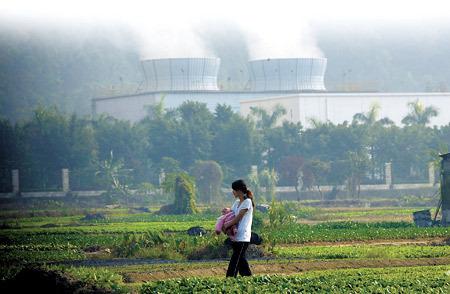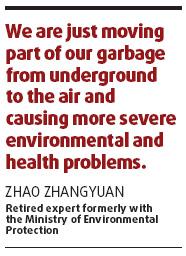
Zhang Xiemei, 32, walks outside her home with her daughter in Likeng village, Guangdong province, where a major waste incineration plant was opened in 2005. [China Daily]
As she looked at the plumes of smoke billowing into the skies from the nearby garbage incinerator, Zhang Xiemei hugged her baby and dreamed of one day taking her away from Likeng.
The grocery store owner has been growing more concerned about the health of her 14-month-old daughter since several cases of lung cancer were reported among her neighbors.
"The incinerator is too close to my apartment, I'm really worried my baby will get sick," said Zhang, 32, who moved to the village in Baiyun district of Guangzhou, capital of Guangdong province, with her husband seven years ago. "More people are considering leaving here. We can smell the thick stench of burning trash, and it is getting stronger every day."
The incinerator opened in 2005 and phase two of the project is expected to start next year, according to the local authorities.
"The situation will only get worse," said a 72-year-old resident surnamed Huang. "We already have to get drinking water from outside of the village. The water here can only be used for irrigating the crops. No one feels safe drinking from the local wells any more."
Local officials on Sunday told a press conference that no workers at the Likeng project had been reported to have cancer. However, Zhang and Huang are among the thousands of residents across China already living near waste incineration plants.
Many authorities also plan to construct even more facilities to cope with the country's growing mountains of garbage.
The situation has led to several high-profile protests by citizens demanding a halt to proposed projects, and Chinese experts have warned such standoffs pose a real threat to social stability in the country.
To allay fears and put an end to the controversy surrounding waste treatment plants, the Ministry of Environmental Protection has announced it is working to tighten emission standards for waste incineration plants.
The new standards for dioxins, highly toxic compounds found in emissions that have been linked to cancer, and other pollutants will be "consistent" with international levels, an official with the ministry's pollution prevention department who asked not to be named said yesterday.
He said all incinerators will be ordered to upgrade facilities and follow the new standards, although he failed to elaborate on a timetable or specific plan.
But even with the stricter supervision, many specialists in waste management still say that the government is moving in the wrong direction by trying to solve the country's garbage problem by building more incinerators.
"We are just moving part of our garbage from underground to the air and causing more severe environmental and health problems," said Zhao Zhangyuan, a retired official formerly with the ministry.

Landfills and incineration are the two most common methods of waste treatment in China, and both have dangers. Landfill sites, where the refuse is buried, can leak and release toxic gas, while burning rubbish at incinerators releases dioxins, chemicals derived from petroleum that, according to the World Health Organization, can damage the human immune and nervous systems.
China's national standard on dioxin emissions is 1 nanogram per cu m - 10 times the allowed amount in the European Union and the United States.
By September last year, 100 incinerators were at various stages of development across the country, with 60 already in operation, showed statistics from the Ministry of Environmental Protection. A report on garbage treatment by the Chinese Academy of Sciences this month, however, said that more than 70 percent of the nation's domestic incinerators would not meet EU standards.
Zhao said the fact China was building so many of incinerators was a disaster.
"Japan is an experienced country in garbage incineration with EU standards, but it is shutting down more than two-thirds of its incinerators due to their negative impact on the environment and humans," said Zhao, adding that US is also shutting down 137 incinerators.
But while developed countries are busy shutting down incinerators, Chinese governors seem to see burning rubbish as the last resort in a losing battle.
China produces about 150 million tons of residential and industrial waste each year, according to China-ie.com, a non-profit organization, but that figure is constantly rising.
A report by the Ministry of Housing and Urban-Rural Development last year warned that more than a third of Chinese cities face a trash crisis and that the annual urban waste per capita is now 220 kg, with 7 billion tons already on disposal sites covering 150,000 hectares in 665 cities, the report said.
"It is a preferred option for us to build more incinerators, since the city is facing rising piles of garbage. We will scientifically select places for such construction outside dense residential areas," said Lu Zhiyi, deputy general-secretary of the Guangzhou government.
However, proposals have put citizens and officials at loggerheads, with the most recent conflict in Guangzhou on Monday, when more than 1,000 people protested outside the local government's offices over plans to construct a large garbage plant in Huijiang, a village in the city's Panyu district.
Most who attended the rally told China Daily they were strongly opposed to the authority's attempts to push through the project while environmental assessments were still under way.
In a poll of more than 1,500 residents by the Guangdong Situation Study and Research Center, 92 percent felt the plant posed a serious danger to their health and the local natural environment, while 97 percent said they opposed its construction. Almost all respondents said they opposed the incinerator projects over fears about dioxins.
Lu An, a 35-year-old protester, said: "We are not simply asking the government to move the project out of Panyu. Wherever it is located, burning garbage harms people's health and the environment, and we will protest."
Following the public outcry, the local government said it would open more channels to solicit public opinion about the incinerator plans over the next six months, and even suggested the public could be allowed to vote on the project.
"If a large majority of people are opposed to the project, or it does not pass the environmental assessments, we will not start construction," said Lou Kuixu, director of Panyu district government. "We will later launch a series of activities to promote the public knowledge about garbage incineration."
More than 10 large residential areas housing mostly white-collar workers are located within 30 km away from Huijiang village. And Zhang Jianguo, deputy director of the Guangzhou Center of Urban Construction and Administration, told China Daily: "We may have to select another place for the project. Many people live around the planned site."
Abandoning the incinerator project, which was intended to replace two small landfills in Huijiang, poses an equally big problem for the government.
Panyu has a population of 2.5 million, who are served by five small landfill sites and garbage incinerators, with a daily capacity of 600 tons of garbage. But according to local authority statistics, the district last year produced in excess of 600,000 tons of trash - more than 1,600 tons a day - which was a 12-percent increase year-on-year.
"The current facilities cannot meet the rising demand," said Lu Zhiyi, who explained that the planned incinerator would have a daily capacity of 2,000 tons. "If we do not introduce new ways to deal with trash, Guangzhou will face real challenges in the years ahead."
Officials insisted that state-of-the-art facilities would be introduced from overseas for the Huijiang project, to minimize pollution from burning garbage. But expert Zhao said governments should instead invest the money in revising trash classification, recycle and utilization systems, which would help to decrease the volume of waste.
"Reducing the amount of trash from each household, and separating and recycling are still key to relieving the heavy burden of waste treatment," agreed Feng Yongfeng, senior science reporter for Guangming Daily, a newspaper based in Beijing.
In a recent blog, he predicted that, as the population grows and domestic consumption booms, incinerators will never meet the demand.
Feng Shengping, a researcher with the Guangdong Situation Study and Research Center, said the dispute between residents and the government over the Huijiang project showed citizens are determined to seek a better life, free of pollution.
"Chinese people have attached more importance to their living environment rather than simply making money," Feng said. "In Panyu, if the government had publicized its decision to begin construction earlier, officials would have had more room to rethink the policy."
The Panyu land resources bureau approved the project in April this year, but residents say they were only informed of the proposed construction through local media in September.
"We want more transparency from the government," said protester Lu An. "We are all very concerned about pollutants to the environment."





